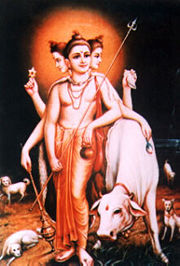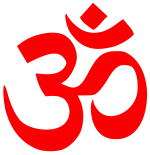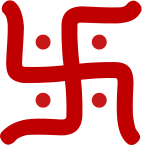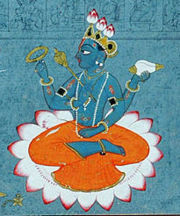Avatar
Avatar or Avatara (Sanskrit: अवतार, IAST Avatāra), often translated into English as incarnation, literally means descent (avatarati) and usually implies a deliberate descent from higher spiritual realms to lower realms of existence for special purposes. Descents that are of importance are mainly that of the Supreme Being which are plenary and marked with superhuman qualities. Other types of descents are limited expansions of Ishvara, and some that are descents of lesser empowered divinities. The term is used primarily in Hinduism for descents of Vishnu whom Vaishnava Hindus (one of the largest branches of Hinduism)[1] worship as the Supreme God, a distinctive feature of Vaishnavism. While Shiva and Ganesha are also described as descending in the form of avatars, with the Ganesha Purana and the Mudgala Purana detailing Ganesha's avatars specifically, the avatars of Vishnu carry a greater theological prominence than those of Shiva or Ganesha and upon examination relevant passages are directly imitative of the Vaishnava avatara lists.[2]
Contents |
Avatars of Vishnu
The most traditional form of Avatar within Hinduism is the descents of Vishnu, the preserver or sustainer aspect of God within the Hindu Trinity or Trimurti.
Dasavatara: Ten Avatars of Vishnu in the Garuda Purana

The ten most famous descents of Vishnu are collectively known as the "Dasavatara" ("dasa" in Sanskrit means ten). This list is included in the Garuda Purana (1.86.10"11) and denotes those avatars most prominent in terms of their influence on human society.[3]
The first four are said to have appeared in the Satya Yuga (the first of the four Yugas or ages in the time cycle described within Hinduism). The next three avatars appeared in the Treta Yuga, the eighth descent in the Dwapara Yuga and the ninth in the Kali Yuga. The tenth is predicted to appear at the end of the Kali Yuga in some 427,000 years time.[4]
- Matsya, the fish, appeared in the Satya Yuga.
- Kurma, the tortoise, appeared in the Satya Yuga.
- Varaha, the boar, appeared in the Satya Yuga.
- Narasimha, the half-man/half-lion appeared in the Satya Yuga.
- Vamana, the dwarf, appeared in the Treta Yuga.
- Parashurama, Rama with the axe, appeared in the Treta Yuga.
- Rama, Ramachandra, the prince and king of Ayodhya, appeared in the Treta Yuga.
- Krishna (meaning "dark coloured" or "all attractive") appeared in the Dwapara Yuga along with his brother Balarama. According to the Bhagavata Purana Balarama is said to have appeared in the Dwapara Yuga (along with Krishna) as a descent of Ananta Shesha. He is also counted as an avatar of Vishnu by the majority of Vaishnava movements and is included as the ninth Dasavatara in some versions of the list which contain no reference to Buddha.
- Gautama Buddha (meaning "the enlightened one") appeared in the Kali Yuga (specifically as Siddhartha Gautama).
- Kalki ("Eternity", or "time", or "The Destroyer of foulness"), who is expected to appear at the end of Kali Yuga, the time period in which we currently exist, which will end in the year 428899 CE.
In some versions the 9th avatar is Balarama (elder brother of Krishna).
Avatars of Vishnu in the Bhagavata Purana


Twenty-two avatars of Vishnu are listed numerically in the first Canto of the Bhagavata Purana as follows:[5]
- Catursana [SB 1.3.6] (The Four Sons of Brahma)
- Varaha [SB 1.3.7] (The boar)
- Narada [SB 1.3.8] (The Traveling Sage)
- Nara-Narayana [SB 1.3.9] (The Twins)
- Kapila [SB 1.3.10] (The Philosopher)
- Dattatreya [SB 1.3.11] (Combined Avatar of The Trimurti)
- Yajna [SB 1.3.12] (Vishnu temporarily taking the role of Indra)
- Rishabha [SB 1.3.13] (Father of King Bharata)
- Prithu [SB 1.3.14] (King who made earth Beautiful and Attractive)
- Matsya [SB 1.3.15] (The Fish)
- Kurma [SB 1.3.16] (The Tortoise)
- Dhanvantari [SB 1.3.17] (Father of Ayurveda)
- Mohini [SB 1.3.17] (Beautiful/Charming Woman)
- Narasimha [SB 1.3.18] (The Man-Lion)
- Vamana [SB 1.3.19] (The Dwarf)
- Parasurama [SB 1.3.20] (The Rama with an Axe)
- Vyasa [SB 1.3.21] (Compiler of the Vedas)
- Rama [SB 1.3.22] (The King of Ayodhya)
- Balarama [SB 1.3.23] (Krishna's Elder Brother)
- Krishna [SB 1.3.23] (The Cowherd also Svayam Bhagavan)
- Buddha [SB 1.3.24] (The Deluder)
- Kalki [SB 1.3.25] (The Destroyer)
Besides these, another three avatars are described later on in the text as follows:
- Prshnigarbha [SB 10.3.41] (Born to Prshni)
- Hayagriva [SB 2.7.11] (The Horse)
- Hamsa [SB 11.13.19] (The Swan)
After Kalki avatar is described in the Bhagavata Purana it is declared that the avatars of Vishnu are 'innumerable.'[6] However the above list of twenty five avatars is generally taken as of those of greatest significance.
According to Gaudiya Vaishnava interpretation of a verse in the latter texts of the Bhagavata Purana,[7] and a number of texts from the Mahabharata and other Puranic scriptures,[8] Chaitanya Mahaprabhu is also listed as an avatar and is worshiped as such by followers of the tradition. In this connection Chaitanya is often referred to as the Golden Avatar.
|
Part of a series on |
 |
|
Beliefs and practices
Dharma · Artha · Moksha · Karma · Samsara |
|
Scriptures
Vedas |
|
Related topics
Hinduism by country |
|
|
Although it is usual to speak of Vishnu as the source of the avataras, within the Vaishnavism branch of Hinduism Vishnu is only one divine being that manifests in form. In that tradition Narayana, Vasudeva and Krishna are also seen as names denoting divine aspects which take avataric form.[2] In addition there are other senses and shades of meaning of the term avatar within Hinduism.
Purusha avatars
Purusha avatars are sometimes described as the original avatars of Vishnu or Krishna within the Universe:[9][10]
- Vasudeva
- Sankarshan
- Pradyumna
- Aniruddha
Guna avatars
The personalities of the Trimurti (Hindu trinity) are also sometimes referred to as Guna avatars, because of their roles of controlling the three modes (gunas) of nature,[10] even though they have not descended upon an earthly planet in the general sense of the term 'avatar'.
- Vishnu - As controller of the mode of goodness (sattva)
- Brahma - Controller of the mode of passion and desire (rajas)
- Shiva - Controller of the mode of ignorance (tamas)
Manvantara avatars
Manvantara avatars are beings responsible for creating progeny throughout the Universe, said to be unlimited in number. [11] They do not take birth.
Shaktyavesa and Avesa avatars
Avataric incarnations are classified as two kinds
- direct (sakshat)
- indirect (avesa).
When Vishnu himself descends, he is called sakshat or shaktyavesa-avatara, a direct incarnation of God. But when he does not incarnate directly, but indirectly empowers some living entity to represent him, that living entity is called an indirect or avesa avatar.[12]
There are said to be a great number of avesa avatars. Examples include Narada Muni, Shakyamuni Buddha, and Parashurama. Parashurama is the only one of the traditional ten avatars that is not a direct descent of Vishnu.
According to the Sri Vaishnavism sect of Hinduism, there are two types of primary or direct avatars, Purna avatars and Amsarupavatars:
- Purna avatars are those in which Vishnu takes form directly and all the qualities and powers of God are expressed, (e.g. Narasimha, Rama and Krishna). [13]
- Amsarupavatars are those in which Vishnu takes form directly but He is manifest in the person only partially. (e.g. avatars from Matsya to Parashurama).
The avesa or indirect avatars are generally not worshiped as the Supreme being. Only the direct, primary avatars are worshiped in this way. In practice, the direct avatars that are worshiped today are the Purna avatars of Narasimha, Rama and Krishna. Among most Vaishnava traditions, Krishna is considered to be the highest Purna avatar. However, followers of Chaitanya (including ISKCON), Nimbarka, and Vallabha Acharya differ philosophically from other Vaishnavas, such as Ramanujacharya and Madhvacharya, and consider Krishna to be the ultimate Godhead, not simply an avatar. That said, all Hindus believe that there is no difference between worship of Vishnu and His avatars as it all leads to Him. According to Madhvacharya (chief proponent of Dvaita or school of differential monism), all avatars of Vishnu are alike in potency and every other quality. There is no gradation among them, and perceiving or claiming any differences among avatars is a cause of eternal damnation. See Madhva's commentary on Katha Upanishad, or his Mahabharata-Tatparya-Nirnaya.
People who have been considered avatars outside the orthodox tradition of Hinduism
-
For more details on this topic, see List of people who have been considered avatars.
Besides the avatars of Hinduism listed in the Puranas and Vedas, some other Indian people are considered to be avatars by themselves or by others. Some of these include:
- Meher Baba (1894–1969) said he was the avatar of this age.[14][15]
- Mother Meera (1960–present) claims and is believed to be an Avatar of Adipara-Shakti.[16]
- Sathya Sai Baba (1926–present) claims and is believed by his devotees to be an avatar of Shiva, Shakti and Krishna.[17]
While many Hindus reject the idea of avatars outside of traditional Hinduism, some Hindus with a universalist outlook view the central figures of various non-Hindu religions as avatars. Some of these religious figures include:
- Jesus (4 BC–36) whose teachings inspired Christianity.[18] See also Incarnation (Christianity).
- Zoroaster (Zarathustra) the prophet of Zoroastrianism.[19]
See also
- Hindu deities
- Svayam bhagavan
- Gautama Buddha in Hinduism
- List of people who have been considered avatars
- Avatars in Mahabharata
References
- ↑ Major Branches - Hinduism from adherents.com
- ↑ 2.0 2.1 Matchett, Freda, Krsna, Lord or Avatara? the relationship between Krsna and Visnu: in the context of the Avatara myth as presented by the Harivamsa, the Visnupurana and the Bhagavatapurana, Routledge, 2000
- ↑ Garuda Purana (1.86.10–11)
- ↑ B-Gita 8.17 "And finally in Kali-yuga (the yuga we have now been experiencing over the past 5,000 years) there is an abundance of strife, ignorance, irreligion and vice, true virtue being practically nonexistent, and this yuga lasts 432,000 years. In Kali-yuga vice increases to such a point that at the termination of the yuga the Supreme Lord Himself appears as the Kalki avatara."
- ↑ Bhag-P 1.3 Canto 1, Chapter 3
- ↑ Bhag-P 1.3.26
- ↑ Bhag-P 11.5.32 "In the age of Kali, intelligent persons perform congregational chanting to worship the incarnation of Godhead who constantly sings the names of Krishna. Although His complexion is not blackish, He is Krishna Himself."
- ↑ Vedic Encyclopedia "Sri Caitanya Mahaprabhu predicted"
- ↑ Avatar - Categories of Incarnations
- ↑ 10.0 10.1 gaudiya.com - theology
- ↑ Avatar - Categories of Incarnations, by Atmatattva Das, 06/17/2005 [1]
- ↑ Teachings of Lord Chaitanya - Avatars
- ↑ Types of Avatars; answers to questions #67-70.
- ↑ Purdom, Charles B.: "The God-Man: The Life, Journeys & Work of Meher Baba with an Interpretation of His Silence & Spiritual Teaching", George Allen & Unwin, London, 1962. p. 15.
- ↑ Meher Prabhu: Lord Meher, The Biography of the Avatar of the Age, Meher Baba, Manifestation, Inc. 1986, by Bhau Kalchuri, pp. 1349, 4973, 6018, 6051.
- ↑ Adilakshmi, "The Mother", page 4.
- ↑ "The Revelation", Sathya Sai Speaks VI, 210–213, 17 May 1968.
- ↑ Meher Prabhu: Lord Meher, The Biography of the Avatar of the Age, Meher Baba, Manifestation, Inc. 1986, by Bhau Kalchuri, p. 5054.
- ↑ Meher Prabhu: Lord Meher, The Biography of the Avatar of the Age, Meher Baba, Manifestation, Inc. 1986, by Bhau Kalchuri, p. 223.
External links
- Vedic Knowledge Online - Avataras as categorized within Gaudiya Vaishnavism
- Diagram showing the 'family tree' of different Avatars
- Description of different Avatar types
- Dasavatara stotra and the ten avataras (salagram.net)
- Avatars with meanings (srivaishnavam.com)
- The divine incarnation in Hinduism and Christianity article by Ernest Valea
- Encyclopedia of Authentic Hinduism - Philosophy of the descension (avatar) of God
- Avatars (Incarnations or Descents) of Vishnu
- Krishna's avataras (krishna.com)
- Explores the claims made by various possible Avatars
- New York Times on origin and use of word avatar
|
||||||||||||||
|
|||||

